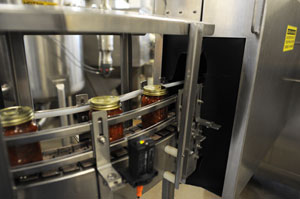Through four generations, Winston-Salem-based T.W. Garner Company has developed and delivered specialty food products to the American market. Texas Pete’s hot sauce adds a zip for many food enthusiasts. Most recently, Green Mountain Gringo Salsa has provided a high-quality accompaniment to chips and snacks.
The Green Mountain Gringo Salsa home page heralds this product is, “Filled and Inspected One Jar at a Time.” The tag line pre-dated the installation of the processor’s new glass line X-ray inspection system; however, it has long provided the guidance and direction for how the salsa is processed.

|
|
The ScanTrac Trio was installed over T.W. Garner’s existing conveyor and inspects up to 400 jars per minute. Three beams identify any irregular-shaped glass contaminants. Source: InspX. |
Gerald Lambert, general manager—facilities, confirms maintaining a “One Jar at a Time” standard while offering the product at a competitive price has dictated that Garner use the highest-quality production equipment.
“Since we believe in glass packaging as a key element in delivering quality food products to the consumer, we wanted to assure each had been inspected for glass materials that may have been introduced somewhere in the process here,” says Lambert.
Lambert and select team members traveled to California to evaluate the ScanTrac systems offered by InspX and were convinced this was an investment that resonated with the way the Garner operates.
After working through the challenges of installing a new packaging line for the salsa in early 2011, Lambert and the balance of the management team revisited the proposals from InspX and learned its two beam X-ray system for inspecting glass containers had been enhanced by the addition of a third beam, the ScanTrac Trio.
“The Trio easily installs over our existing conveyor,” observes Lambert. “I just had to find the linear space on the line to put this in. We decided on a location just downstream of the labeler. Since there is no container contact, maintenance is not an issue.
“The results have been outstanding,” continues Lambert. “We feel we get three benefits from the system. First, when the system detects a fault, we can immediately assess the source and take corrective action. For example, if there is any irregularity in the package—such as the presence of foreign material, under-filled jars or missing lids—[the jar] will be immediately ejected from the line. Second, if we have received some irregular glass that may pose a risk in shipment, we can stop and make a decision about proceeding or not. Finally, by challenging the system regularly during the day with a glass-in-glass test jar, we know the Trio is doing its thing, and we can sleep more comfortably with this risk being prudently addressed.”
The Trio system’s two outer beams are at 90° to optimize the inspection around the pushup on the bottom of the jar. The three beams (each at a different angle) greatly increase the probability irregular-shaped glass contaminants will project one X-ray detectable dimension into the image for analysis. Capable of operating at speeds in excess of 1,200 containers per minute, the Trio provides ample inspection capacity for the 400 jars per minute at T.W. Garner.
For more information: Allan Anderson, 510-226-6686 X3055, anderson@inspx.com




